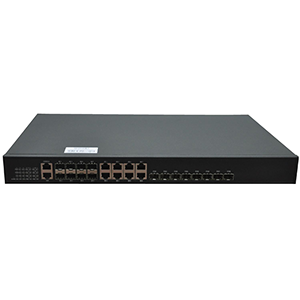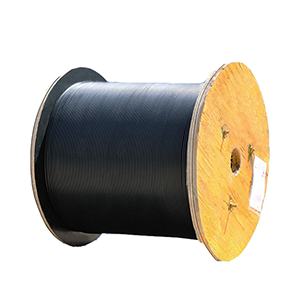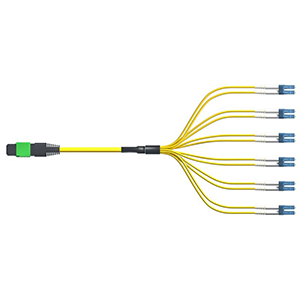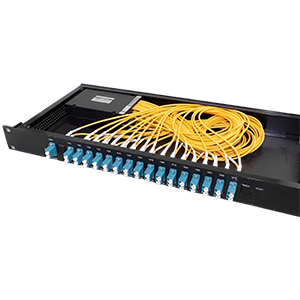Fiber optic networks undoubtedly play an important role in modern communications. This article will focus on the concepts of passive fiber optic networks. We will first define the basic architecture and components of passive fiber optic networks and explain their advantages over active fiber optic networks. Next, we will explain the signal transmission mechanism of passive fiber optic networks and analyze the key role of optical splitters in it.
We will introduce the advantages of passive fiber optic networks in terms of bandwidth, cost, etc., and explain their performance in terms of reliability and maintainability. In addition, we will list typical passive fiber optic network application environments and analyze their applicability in different applications. Finally, we will describe the planning and design points of passive fiber optic networks and explain their correct deployment and debugging methods.
What is a passive fiber optic network
Let me give you a detailed introduction to what a passive fiber optic network is and its advantages over an active fiber optic network.
Basic architecture and components of passive optical network:
(1) Definition:
- Passive Optical Network (PON) is a broadband access network technology based on optical fiber.
- It adopts a point-to-multipoint tree topology and uses a splitter to distribute optical signals to multiple user terminals.
(2) Basic architecture:
- Central office (OLT): core equipment that provides optical signal source and modulation and demodulation functions
- Splitter: passive optical device used to distribute or merge signals
- User terminal equipment (ONT/ONU): access equipment for each terminal user
(3) Working principle:
- OLT broadcasts downlink signals to the splitter, which distributes them to each user terminal
- Each user terminal sends an uplink signal, which is aggregated to the OLT by the splitter
The passive optical fiber network consists of three parts: OLT, splitter and user terminal, and uses passive splitting technology to achieve point-to-multipoint communication.
Advantages of passive fiber optic network over active fiber optic network:
(1) Cost-effectiveness
- Passive fiber optic network does not require intermediate active equipment, and the initial investment and operation and maintenance costs are lower.
- Compared with active fiber optic network, it has better economic performance.
(2) Reliability
- Passive fiber optic network does not have active equipment failure, and the overall reliability is higher.
- Even if the splitter is damaged, it will only affect a few users and will not cause the entire network to be paralyzed.
(3) Flexibility
- The tree topology of passive fiber optic network is easy to expand and can be flexibly increased or decreased according to user needs.
- Easy to achieve passive distribution and aggregation from the central office to the user end.
(4) Power demand
- Only user terminals in a passive fiber network require power supply, and intermediate passive devices do not need power supply.
- Compared with active fiber networks, the overall power consumption is lower.
(5) Easy maintenance
- Passive devices in passive fiber networks do not require complex configuration and management.
- It is more conducive to troubleshooting and maintenance for network managers.
In short, passive fiber networks are significantly superior to active fiber networks in terms of cost, reliability, flexibility and maintenance, and are the mainstream technology choice for current fiber access networks.
How passive fiber networks work
Let me explain in detail the working principle of passive fiber networks, especially the key role of optical splitters in them.
Signal transmission mechanism of passive optical fiber network:
(1) Downlink transmission
- The central office OLT broadcasts the downstream signal to each user terminal ONT/ONU through optical fiber.
- The optical splitter distributes the downstream signal of OLT equally to different user terminals.
- Each user terminal receives its own downstream data frame and processes it accordingly.
(2) Uplink transmission
- Each user terminal ONT/ONU sends the upstream data to the splitter through optical fiber.
- The splitter aggregates the upstream signals of each user to the OLT.
- OLT receives and processes the upstream data frames from different users.
(3) Time Division Multiplexing
- The passive optical fiber network uses TDMA technology to realize time division multiplexing of the upstream signal.
- OLT controls each user terminal to send upstream data in the specified time slot.
- Avoids the collision and conflict of the upstream signal.
The passive optical fiber network relies on passive optical splitters to realize downstream broadcasting and upstream aggregation, and coordinates the upstream transmission with the help of TDMA technology.
The key role of optical splitters in passive optical fiber networks:
(1) Signal distribution
- The optical splitter distributes the downstream signal of the OLT to each user terminal.
- It realizes point-to-multipoint signal broadcast distribution.
(2) Signal aggregation
- The optical splitter aggregates the uplink signals of each user terminal to the OLT.
- Merge the uplink signals of multiple users into one signal.
(3) Passive implementation
- The optical splitter is a passive optical device that does not require external power supply.
- Makes the entire network architecture simple and reliable, without the need for management and maintenance.
(4) Support topology expansion
- The splitting ratio of the optical splitter can be flexibly adjusted according to demand.
- It is easy to expand the user scale and meet the growth demand of network capacity.
(5) Improve reliability
- Even if the optical splitter fails, it will only affect some users and will not cause the entire network to be paralyzed.
- Improve the reliability and fault tolerance of the entire passive optical fiber network.
In general, the optical splitter is the core component of the passive optical fiber network. It realizes the distribution and aggregation of signals and is the key to maintaining the passive characteristics and reliability of the entire network architecture.
Technical characteristics of passive optical fiber network
Let me introduce in detail the technical characteristics of passive optical fiber network in terms of bandwidth, cost, reliability and maintainability.
Advantages of passive optical fiber network in terms of bandwidth and cost:
(1) Bandwidth advantage
- Passive optical fiber network uses optical fiber transmission and can provide Gbps-level broadband access capabilities.
- It meets the current and future needs of network users for high-speed bandwidth.
(2) Cost advantage
- Passive fiber optic networks do not require intermediate active equipment, and the initial construction and operation and maintenance costs are low.
- It has a good return on investment and total cost of ownership advantage.
(3) Scalability
- The tree-like topology of the passive fiber optic network is easy to expand, and users can be flexibly increased or decreased according to demand.
- When expanding capacity, only user terminal equipment needs to be added, and there is no need to change the intermediate backbone network.
(4) Energy consumption advantage
- Only the user terminal of the passive fiber optic network needs power supply, and the overall energy consumption is low.
- It is conducive to the realization of a green and environmentally friendly network infrastructure.
Passive fiber networks are significantly superior to traditional copper access networks in terms of bandwidth capacity, cost-effectiveness and scalability.
Performance of passive fiber networks in terms of reliability and maintainability:
(1) Reliability
- Passive fiber networks have no intermediate active devices and no single point of failure risk.
- Even if the optical splitter is damaged, it will only affect some users and will not cause the entire network to be paralyzed.
(2) Anti-interference
- Fiber transmission is immune to electromagnetic interference, and signal transmission is more stable and reliable.
- Compared with copper cable networks, the anti-interference performance is greatly improved.
(3) Convenient maintenance
- The passive components of passive fiber networks do not require complex configuration and management.
- Fault location and equipment maintenance are simpler and more efficient than active networks.
(4) Long-term operation
- The optical fiber transmission medium has a long life, and the passive optical fiber network has better sustainability.
- No need to frequently replace network equipment, and the operation and maintenance cost is low.
(5) Security
- The passive optical fiber network based on optical fiber is difficult to be accessed by unauthorized users.
- Compared with copper cable networks, it has better line security protection performance.
In short, the passive optical fiber network has excellent performance in reliability, anti-interference and security due to its passive design and optical fiber transmission characteristics, which greatly improves the stability and maintainability of the network.
Application scenarios of passive fiber networks
Let me introduce you in detail the typical application scenarios of passive fiber networks and their applicability in different environments.
- Typical application scenarios of passive fiber networks:
(1) Home broadband access
- The most widely used application of passive fiber networks is to provide broadband access services to home users.
- Its high bandwidth, low cost and easy expansion are very suitable for this application scenario.
(2) Enterprise campus network
- Passive fiber networks are also widely used in the construction of access networks within enterprise campuses.
- It can meet the needs of enterprises for high-speed, reliable and secure networks.
(3) Metropolitan Area Network Construction
- Some cities and communities also use passive fiber networks as the access basis for metropolitan area networks.
- With its good cost-effectiveness and easy scalability, it is conducive to accelerating urban broadband coverage.
(4) Telecom Operator Network
- Passive fiber networks are widely used in the access networks of telecom operators.
- As a bearer network connecting the core network and users, its reliability and scalability are critical.
(5) Military and Government Networks
- Some special scenarios such as military and government departments also use passive fiber networks.
- Its security and reliability can meet the special needs of these fields.
Passive fiber optic networks are widely used in various civil and professional networks due to their outstanding technical advantages.
Applicability of passive fiber optic networks in different applications:
(1) Home broadband
- The high bandwidth, low cost and easy scalability of passive fiber optic networks are most suitable for the needs of home users.
- It is the main application scenario with the largest market share.
(2) Enterprise network
- The high reliability and security of passive fiber optic networks meet the needs of enterprise networks.
- It is widely used in large-scale campus networks and campus networks.
(3) Metropolitan area network
- Passive fiber optic networks are easy to deploy on a large scale, which is conducive to accelerating urban broadband coverage.
- It plays an important role in urban infrastructure construction.
(4) Operator Network
- The stability and scalability of passive fiber networks meet the requirements of operator networks.
- It is the main technical choice for operator access networks.
(5) Professional Applications
- The security and reliability of passive fiber networks meet the needs of some special scenarios.
- It has special applications in military, government and other fields.
In general, passive fiber networks have shown their unique technical advantages in different application scenarios and are currently the most mainstream broadband access network solution.
Design and Deployment of Passive Fiber Networks
Let me introduce you to the key points of design and deployment of passive fiber networks in detail.
Planning and design of passive fiber optic network:
(1) Demand analysis
- Accurately evaluate the number of users, business types, and bandwidth requirements to determine network construction goals.
- Reserve appropriate expansion space according to future development trends.
(2) Network topology
- Determine the tree topology of the network, including the deployment locations of OLT, optical splitters and user terminals.
- Reasonably design the splitting ratio of the optical splitter to meet the user density in different areas.
(3) Fiber planning
- Determine the laying path and length of trunk optical fiber and branch optical fiber.
- Reasonably reserve optical fiber protection pipelines and redundant lines to improve reliability.
(4) Equipment selection
- Select OLT, optical splitters and ONT/ONU equipment that meet the standards.
- Ensure technical compatibility and interoperability between various devices.
(5) Energy supply
- Rationally plan the power supply scheme for OLT and user terminals.
- Try to reduce active equipment and reduce overall energy consumption.
The planning and design of passive optical fiber networks need to comprehensively consider many factors such as user needs, network topology, optical fiber deployment and equipment selection.
Deployment and commissioning of passive optical fiber networks:
(1) Construction deployment
- Lay trunk optical fiber and branch optical fiber in an orderly manner according to the design plan.
- Rationally arrange OLT, optical splitter and user terminal equipment.
(2) System integration
- Connect and configure OLT, optical splitter and ONT/ONU equipment step by step.
- Ensure effective connectivity and collaborative work between subsystems.
(3) Performance debugging
- Use professional test instruments to detect optical power, dispersion and attenuation parameters of optical fiber links.
- Adjust the splitting ratio of the optical splitter to optimize network performance indicators.
(4) Acceptance test
- Comprehensively test the stability, reliability and transmission performance of the network.
- Ensure that the network indicators meet the design requirements before it can be officially delivered for use.
(5) Daily maintenance
- Establish a complete daily inspection and fault response mechanism.
- Discover and eliminate hidden dangers in optical fiber, equipment, etc. in a timely manner.
In short, the deployment of passive optical fiber networks needs to strictly follow the design plan and adopt professional debugging and testing methods to ensure that the network can operate stably and efficiently after it is put into use.
Summary
Reasonable deployment of passive optical fiber networks can effectively meet the needs of modern communications for high-speed and low-cost access. Our company has long been focusing on the research and development and production of optical communication equipment and its supporting products, and has rich industry experience. Our passive optical fiber network solutions have reached the industry-leading level in terms of performance and reliability, and can meet your demanding needs for high-speed access network construction.
Whether you need to deploy passive optical fiber in the network of telecom operators, government and enterprise users, or home users, we can provide you with customized solutions. At the same time, our professional team will provide you with a full range of technical support, including on-site surveys, solution design, and equipment installation and maintenance. Contact us now to learn more about passive optical fiber networks.
Passive Optical Networking FAQ
PON is a fiber-optic network architecture that uses passive optical components, such as splitters and combiners, to provide broadband services to multiple end-users from a single optical line terminal (OLT).
In a PON network, the OLT at the service provider’s central office is connected to multiple optical network units (ONUs) at the subscriber premises through a passive optical splitter.
The key components are the OLT, optical splitter, and ONUs. The OLT is the central office equipment, while the ONUs are the customer-premises equipment.
The OLT transmits downstream data to all connected ONUs using time division multiplexing (TDM). For upstream data, the ONUs share the same wavelength using time division multiple access (TDMA).
The main PON technologies include GPON (Gigabit-capable PON), EPON (Ethernet PON), and XG-PON (10 Gigabit-capable PON), each with different data rates and technical specifications.
Key benefits include cost-effectiveness, energy efficiency, high bandwidth, and the ability to serve a large number of subscribers from a single fiber.
In a point-to-point network, each subscriber has a dedicated fiber connection, while in a PON, a single fiber is shared among multiple subscribers using passive optical splitters.
Potential challenges include ensuring optimal power budget, managing fiber splitter ratios, and coordinating the synchronization of upstream transmissions from different ONUs.
PON networks typically use management protocols, such as OMCI (ONU Management and Control Interface), to facilitate the configuration and monitoring of ONUs from the OLT.
Advancements include the development of higher-speed PON standards (e.g., XGS-PON, NG-PON2), the integration of PON with other network technologies, and the exploration of virtualized and software-defined PON architectures.






